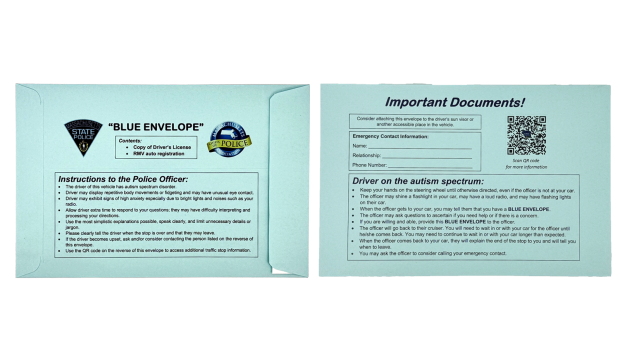Getting your Blue Envelope
You can request a Blue Envelope in one of the following ways:
- Visit one of our barracks to request one in person; or
- Complete our online form to have an envelope mailed to you
Blue Envelopes can only be mailed to Massachusetts addresses.
Preparing your envelope
Once you have your Blue Envelope, the next step is to prepare it properly to ensure it serves its intended purpose during a traffic stop. This preparation not only involves placing the right documents inside but also knowing where to keep the envelope in your vehicle for easy access. Here’s how to get your envelope ready:
- Gather your documents: Include a copy of your current driver’s license and vehicle registration.
- Place documents inside: Put these documents into the Blue Envelope so they are secure and easy to retrieve.
- Choose an accessible location: Attach the Blue Envelope to the driver’s side sun visor or keep it in another visible, easily reachable spot. This makes it quick to present your documents and helps law enforcement recognize the envelope and adjust their communication approach as needed.
- Inform other drivers: If family members or friends may drive your vehicle, tell them where the Blue Envelope is and what it’s for.
- Keep documents current: Replace items in the Blue Envelope with updated versions as soon as you receive them.
Preparing your Blue Envelope in advance helps ensure a smoother interaction during a traffic stop. It reduces stress for you and assists law enforcement in recognizing and responding to the needs of drivers on the autism spectrum. By keeping your Blue Envelope ready and accessible, you help create a safer, more understanding environment for everyone on the road.
Tips for a safe traffic stop
Traffic stops can be stressful for anyone, but they can be especially challenging for drivers on the autism spectrum and for officers who want to handle the situation with care. These tips can help both drivers and law enforcement create a safe and respectful interaction.
For drivers on the autism spectrum
- Stay calm: Take deep breaths to help manage stress.
- Use your Blue Envelope: When the officer arrives, say, “I have a Blue Envelope.” Keep it in an easy-to-reach, visible spot, such as the driver’s side sun visor. When instructed, slowly get the envelope. If the officer is unfamiliar with it, politely ask them to scan the QR code for more information.
- Follow instructions: Listen carefully and follow the officer’s directions. If something is unclear, ask for clarification.
- Wait in your car: If the officer returns to their cruiser, stay in your seat until they return. This may take up to 10–15 minutes. The officer will explain when the stop is over and when you may leave.
- Keep hands visible: Place your hands on the steering wheel and avoid sudden movements. Tell the officer before reaching into your pocket, glove compartment, or elsewhere.
- Expect lights and noise: The officer may shine a flashlight, use their radio, or have flashing lights on their vehicle.
- Ask for help if needed: If you feel overwhelmed or can’t communicate clearly, you may ask the officer to contact your designated emergency contact.
For law enforcement officers
- Recognize the Blue Envelope: It signals that the driver is on the autism spectrum. Follow the communication tips printed on the envelope.
- Be patient: Allow extra time for the driver to process and respond. Avoid rushing them.
- Communicate clearly: Use simple, direct language. Give one instruction at a time. Avoid idioms or complex phrases. Tell the driver when the stop is over and they may leave.
- Watch for non-verbal cues: The driver may show signs of stress, such as repetitive movements, fidgeting, or unusual speech patterns. Bright lights and noise may increase anxiety.
- De-escalate when needed: Reduce sensory input if possible, such as turning off sirens or speaking calmly. If the driver is upset, consider contacting the person listed on the contact card.
Creating a positive outcome
Following these tips helps make traffic stops safer, calmer, and more respectful for everyone. The Blue Envelope program is designed to:
- Give drivers on the autism spectrum a sense of security and confidence.
- Help law enforcement build trust, show compassion, and better serve the community.
Through awareness, preparation, and empathy, we can make our roads safer and more inclusive for all.
Frequently asked questions
Who can request a Blue Envelope?
Any Massachusetts resident with autism spectrum disorder can request a Blue Envelope. If the individual is a minor, a parent or guardian may request it for them.
How much does a Blue Envelope cost?
The Blue Envelope is free. It’s part of our commitment to helping drivers with autism have safer interactions during traffic stops.
What documents should be kept in the Blue Envelope?
Keep a copy of your driver’s license and vehicle registration inside. These are the documents most often requested during a traffic stop.
Can I get more than one Blue Envelope?
Yes. If you have multiple vehicles or if there’s a chance your envelope might be misplaced, you can request additional envelopes. Keep one in each vehicle you drive regularly.
How do law enforcement officers know about the Blue Envelope program?
The Massachusetts State Police partners with law enforcement agencies across the state to provide training and information about the Blue Envelope program. Officers are briefed on the purpose of the envelope and the communication tips provided to help them interact effectively with drivers on the autism spectrum.
What should I do if an officer is unaware of the Blue Envelope during a traffic stop?
Calmly explain its purpose and show the communication tips printed on the envelope. The information is designed to be clear and useful for officers who may not have seen the envelope before.
How can I help spread the word about the Blue Envelope program?
Share your experience and program information with friends, family, and on social media. Advocacy groups and community organizations can also help distribute materials and raise awareness.
I have an event and would like to distribute Blue Envelopes or involve the Massachusetts State Police.
Contact us at blueenvelope@mass.gov.


